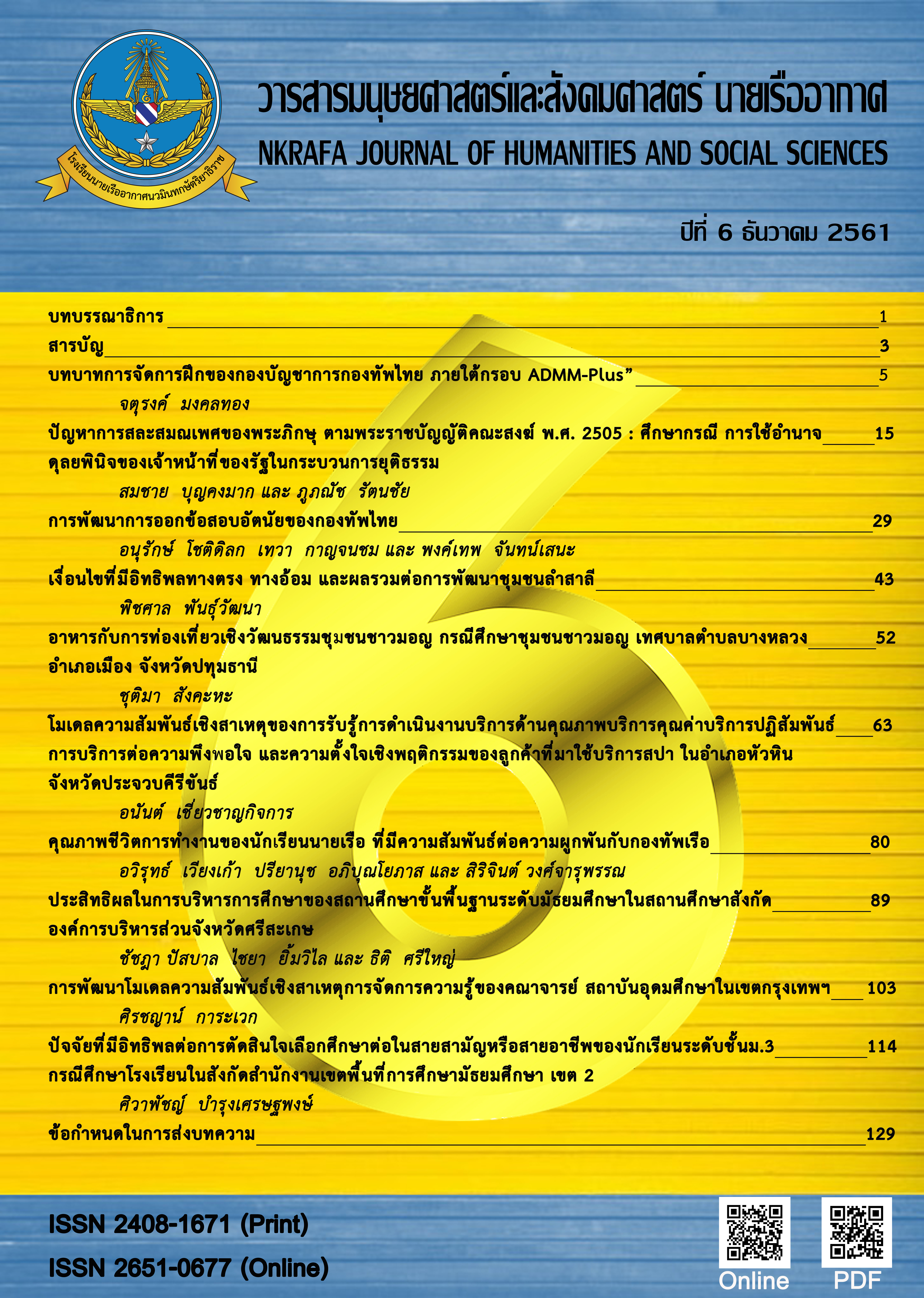FACTORS AFFECTING TO THE DECISION MAKING OF MATHAYOM 3’s STUDENTS IN HIGHER EDUCATION (GENERAL OR VOCATIONAL PROGRAME) : THE CASE OF THE SCHOOL IN SECONDARY EDUCATIONAL SERVICE AREA OFFICE 2
Main Article Content
Abstract
The objectives of this research is to study the factors that affect the decision making in higher education (general scheme or vocational program) focusing on 22,475 students in Mathayom 3, academic year of 2017, from schools under the Secondary Educational Service Area Office 2. The sample group consisted of 660 students was conducted by the method of the Multi Stage Random Sampling. The questionnaire was the tool of this research and the Logistic Regression Analysis was employed for data analysis.
The result can be concluded that there are 12 prediction variables that affected the decision making on higher education between general scheme and vocational program at 0.01 level of significance. These prediction variables are academic performance, performance on science subject, performance on mathematics subject, performance on social study subject, performance on physical education subject, performance on foreign language subject, performance on arts subject, parents’ secondary education, ethical skills, innovation and teamwork skills, gender and the influence from their role model, life skills and analytical skills, parents’ level of vocational certificate, parents’ average income between 20,000 – 30,000 Baht and between 40,001 – 50,000 Baht. All of these variables have an impact on the selection of general scheme or vocational program at 0.10 level of significance. Other variables that are not listed displayed no level of statistic significance. It is found that this model predicted students who decided to pursue general scheme for higher education at 92.40 accuracy rate, and students who selected vocational program at 88.60 accuracy rate from 660 students.
Article Details
บทความที่ได้รับการตีพิมพ์เป็นลิขสิทธิ์ของวารสารมนุษยศาสตร์และสังคมศาสตร์ นายเรืออากาศ
ข้อความที่ปรากฎในบทความแต่ละเรื่องในวารสารวิชาการเล่มนี้ เป็นความคิดเห็นส่วนตัวของผู้เขียนแต่ละท่าน ไม่เกี่ยวข้องกับโรงเรียนนายเรืออากาศฯ และคณาจารย์ท่านอื่น ๆในโรงเรียนนายเรืออากาศฯ แต่อย่างใด ความรับผิดชอบขององค์ประกอบทั้งหมดของบทความแต่ละเรื่องเป็นของผู้เขียนแต่ละท่าน หากมีความผิดพลาดใด ๆ ผู้เขียนแต่ละท่านจะรับผิดชอบบทความของตนเองแต่เพียงผู้เดียว
References
[2] กรมการจัดหางาน. (2557). การเตรียมความพร้อมเพื่อการศึกษาต่อของนักเรียนระดับมัธยมศึกษาปีที่ 3 และปีที่ 6. รายงานการวิจัย กองวิจัยตลาดแรงงาน กรมการจัดหางาน.
[3] กรมการจัดหางาน. (2558). ปัจจัยที่มีผลต่อการตัดสินใจเลือกเรียนต่อสายสามัญและสายอาชีวศึกษาของนักเรียนชั้นมัธยมศึกษาปีที่ 3. รายงานการวิจัย กองวิจัยตลาดแรงงาน กรมการจัดหางาน กระทรวงแรงงาน.
[4] กระทรวงศึกษาธิการ. (2551). หลักสูตรแกนกลางการศึกษาขั้นพื้นฐาน พุทธศักราช 2551.
ค้นเมื่อ 18 ธันวาคม 2560 จาก https://goo.gl/HUNdRk
[5] ทัศนีย์ เทอดธนกาญจน์. (2546). อิทธิพลของบุคคลต้นแบบที่มีต่อพฤติกรรมการเลียนแบบและความตั้งใจซื้อสินค้าที่มีความเกี่ยวกันสูงและต่ำกับวัยรุ่น. วิทยานิพนธ์ปริญญานิเทศศาสตร
มหาบัณฑิต สาขาวิชาการโฆษณา จุฬาลงกรณ์มหาวิทยาลัย.
[6] ปัทมา ว่าพัฒนวงศ์. (2556). การศึกษาวิเคราะห์ผลกระทบเชิงนโยบายต่อการพัฒนาประเทศจากผลการคาดประมาณประชากรของประเทศไทย พ.ศ. 2553 – 2583. กรุงเทพฯ : สำนักคณะกรรมการพัฒนาการเศรษฐกิจและสังคมแห่งชาติ.
[7] ปรัชญนันท์ นิลสุข. (2560). อาชีวศึกษากับประเทศไทย 4.0. วารสารอาชีวะก้าวไกล. ปีที่ 3 (ฉบับที่ 2). หน้า 8-9.
[8] สำนักงานเขตพื้นที่การศึกษามัธยมศึกษา เขต 2. (2560). จำนวนนักเรียนแยกชั้น, เพศ โรงเรียนในสังกัดสำนักงานเขตพื้นที่การศึกษามัธยมศึกษา เขต 2. ค้นเมื่อ 8 ธันวาคม 2560 จาก http://www.kmosa2.org/spm2/ forum/data/00116-6-1.html.
[9] สำนักงานปลัดกระทรวงศึกษาธิการ. (2560). แผนพัฒนาการศึกษาของกระทรวงศึกษาธิการ ฉบับที่ 12 (พ.ศ. 2560 – 2564). ค้นเมื่อ 18 ธันวาคม 2560 จาก http://www.moe.go.th/moe/th/news/ detail.php? NewsID=47194&Key=news20.
[10] อัครเดช นีละโยธิน. (2559). ตัวบ่งชี้ทักษะของนักเรียนในศตวรรษที่ 21 สำหรับการศึกษาขั้นพื้นฐาน : การพัฒนาโมเดลความสัมพันธ์เชิงโครงสร้าง. ดุษฎีนิพนธ์ปริญญาศึกษาศาสตรดุษฎีบัณฑิต สาขาบริหารการศึกษา คณะศึกษาศาสตร์ มหาวิทยาลัยมหามกุฎราชวิทยาลัย.
[11] UNESCO Bangkok Office. (2015). Transversal Skills in TVET : Pedagogies and Assessment. Retrieved December 17, 2017, From http://unesdoc.unesco.org/ images/0023/002354/ 235487e.pdf.


